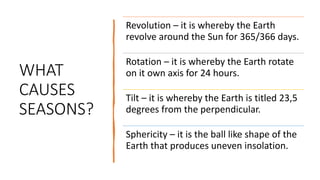The Earth's Energy Balance Presentation.pptx
- 1. THE EARTH'S ENERGY BALANCE THE SIGNIFICANCE OF THE EARTH'S AXIS & REVOLUTION AROUND THE WORLD.
- 2. LEARNING OBJECTIVES ŌĆó List the causes of seasons. ŌĆó Define revolution of the Earth. ŌĆó Demonstrate the rotation of the Earth using a Globe. ŌĆó Differentiate summer and winter characteristics. ŌĆó Value the solstice and the dates where the Sun directly overhead the Equator. ŌĆó Create a Globe.
- 4. WHAT CAUSES SEASONS? Revolution ŌĆō it is whereby the Earth revolve around the Sun for 365/366 days. Rotation ŌĆō it is whereby the Earth rotate on it own axis for 24 hours. Tilt ŌĆō it is whereby the Earth is titled 23,5 degrees from the perpendicular. Sphericity ŌĆō it is the ball like shape of the Earth that produces uneven insolation.
- 5. WHAT ARE SEASONAL EFFECT ON THE ENERGY BALANCE?
- 6. WHAT ARE SEASONAL EFFECT ON THE ENERGY BALANCE? More heat is received in summer than in winter. ŌĆó The Earth axis is tilted. ŌĆó It is the summer season each hemisphere that is tilted towards the Sun. ŌĆó In summer we have longer daytime. ŌĆó In winter when each hemisphere is titled away from the Sun, it receives less incoming radiation. ŌĆó In winter we have shorter daytime.
- 7. WHAT ARE SEASONAL EFFECT ON THE ENERGY BALANCE ŌĆó The Sun is directly overhead the Equator, twice a year, it is on the 21 of March and 23 of September. ŌĆó All places on the Earth have 12-hour day and 12-hour night. ŌĆó Both hemisphere get equal solar radiation.
- 8. WHAT ARE SEASONAL EFFECT ON THE ENERGY BALANCE? The Northern Hemisphere is tilted towards the Sun on the 21 of June. The longer days and shorter nights causes the Northern Hemisphere to experience summer season. The Southern Hemisphere is tilted away from the Sun, causing winter season. The shorter days and longer nights are experienced during this season. On December 21 the reverse happens with long days, short nights and summer in the Southern Hemisphere. The Northern Hemisphere has long nights, short days and winter.
- 9. THE END
- 10. REFERENCE Sutherland, C. (2013) Oxford in search of geography. Cape Town: Oxford University Press Southern Africa. Singh, M., Pillay, V. and Chandrabhaon, S., 2020. EXCEL in Geography.










